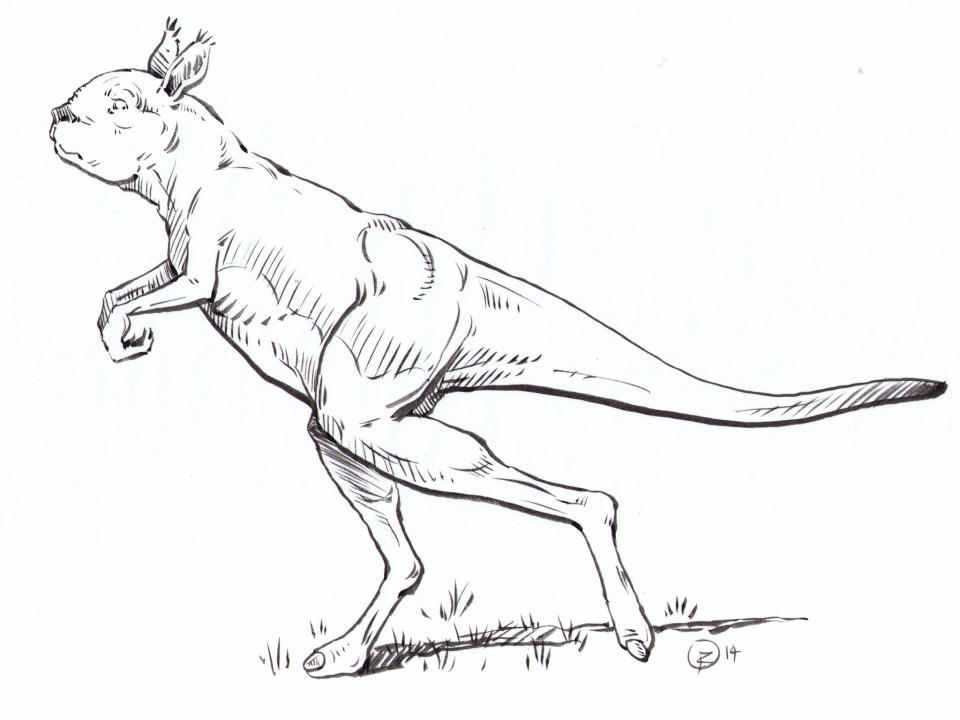Two-tonne wombats and giant walking kangaroos among the Australian megafauna 'wiped out by humans'

A giant kangaroo so big that it had to walk, not hop, a two-tonne wombat and a two-metre tall bird — they may sound like formidable animals, but they never stood a chance.
For years scientists have debated whether human hunting or climate change was the reason for the demise of the astonishing ‘megafauna’ that once inhabited Australia.
Now a new study claims to have finally settled the debate after showing the huge animals were able to survive the increasingly dry climate, but disappeared within a few thousand years of the arrival of the first people.
However, this was no endless slaughter by hunters intent on destruction.
Read more
Scores of primates face 'impending extinction', 31 scientists warn
Long-extinct Nazi super-cows could be brought back by scientists
Dinosaurs may have gone extinct because eggs took so long to hatch
Instead, the researchers concluded the loss of such wonders of the natural world came about through what they described as “imperceptible overkill”. The occasional killing of a young animal was all that it took to tip their populations over the edge and into extinction.
This is a factor in the decline of orangutans today. They are only rarely killed by local people in places like Borneo, giving them the impression that this cannot be a problem. But conservationists have warned it is having a significant effect on the slow-breeding primates, who are also having to cope with the loss of their habitats to agriculture, logging and mining.
The researchers behind the new study, based in the US, Australia and Germany, used an ingenious method to work out what happened to Australia’s megafauna.
Instead of looking for remains on the land, they examined sediments taken from the ocean.
These contained chronological layers of material blown into the sea, including dust, pollen, ash and spores from a fungus that grew on the dung of plant-eating mammals.
From these sediments, they were able to tell what the climate was like and also how much dung was being produced.
And, as one of the researchers, Professor Gifford Miller, of Colorado University, explained, the “abundance of these spores is good evidence for a lot of large mammals on the southwestern Australian landscape up until about 45,000 years ago”.
“Then, in a window of time lasting just a few thousand years, the megafauna population collapsed,” he said.
This sudden decline of large animals in south-western Australia happened about 2,000 years after humans dispersed across the continent, a paper about the research in the journal Nature Communications noted.
This could have been coincidence, but the only other explanation put forward to explain what happened — climate change — appeared to be contradicted by the scientists’ other main finding.
While the climate became drier about 70,000 years ago, prompting a shift from dense eucalyptus woodlands to a more open shrubland, this did not have a noticeable effect on the production of fungus spores.
“We therefore conclude there is no temporal association between climatically driven environmental changes and megafaunal extinction in the south-west region,” the paper said.
“There is also no indication in our data that the megafauna suffered a slow demise commensurate with increases in aridity.”
Human hunting may bring to mind the mass, wanton slaughter of buffaloes after Europeans arrived on the Great Plains of America with powerful rifles and the chance to make a fortune from the animals’ hides.
But the researchers suggested that what happened in Australia would have been barely noticeable to the people responsible.
“It has been estimated that low intensity hunting, such as the killing of just one juvenile per person per decade, could result in a species being extinguished over a few hundred years,” they wrote.
“Such selective, low-level hunting would be virtually imperceptible in the archaeological record, accounting for the lack of reported kill sites.
“In this scenario, all species of megafauna could have been lost from the entire continent within a few thousand years.
“We conclude our results are consistent with extinction being driven by such ‘imperceptible overkill.’”
Among the animals lost to the world during this period was Genyornis newtoni, a flightless bird that stood up to two metres tall.
Last year Professor Miller found the first direct evidence that humans preyed on Australian megafauna — fragments of burned Genyornis eggshells.
The Sthenurus kangaroo — whose appearance has been likened to the White Rabbit from Alice in Wonderland — weighed up to 240kg and walked on two legs, rather than routinely hopping, like its relatives today.
The two-tonne wombat, Diprotodon optatum, is believed to have been the world’s largest marsupial. It was three metres long and two metres high and had pillar-like legs and broad footpads like an elephant. It also had strong claws on its front feet.
Dr Sander van der Kaars, of Australia’s Monash University, who led the research, said: “The results of this study are of significant interest across the archaeological and Earth science communities and to the general public who remain fascinated by the menagerie of now extinct giant animals that roamed the planet — and the cause of their extinction — as our own species began its persistent colonisation of Earth.”

 Yahoo News
Yahoo News 